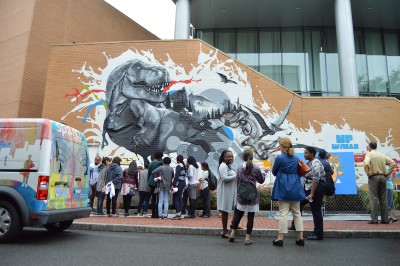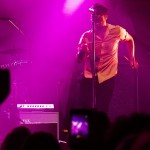
Color and creativity take shape on Northeastern University’s campus as students and faculty welcome a new mural by designer and street artist Cedric Douglas as part of his latest art initiative, Up Walls: Pop Up Street Art Wall.
Funded by the New England Foundation for the Arts with a $10,000 grant and commissioned by Northeastern’s Public Art Initiative, Douglas created the mural with the goal of increasing the presence of street art in Boston.
“It’s going to show people the power of street art,” Douglas said. “Street art is a form of public art and we want to put Boston on the map as a viable public art space.”
Douglas began working on the mural in May, and its public celebration was held at Northeastern University Tuesday. Covering a side of the Behrakis Health Sciences Center, the 50-by-20 foot mural serves in Douglas’ mission to bring the community together through street art.
The spray-painted artwork, titled “A World of Innocent Discovery,” depicts the silhouette of a child holding out a spray can exploding with wonder and wildlife. The lively painting features animals like dinosaurs and prehistoric birds in black and white with vibrant colors strewn across the scene.
The mural even holds double meaning, as it shows insight into the minds of both a child and an artist who are transported by their own creativity, Douglas said.
As a Boston-based artist, Douglas recognizes the power of art and of making it accessible throughout the city. This is why he started his organization the Up Truck, he said, which aims to engage as many locals as possible in the creation process of public art.
“Every day, people want to understand street art and connect with it, as opposed to going to a museum, where they might feel disconnected,” Douglas said. “They see the process, they see it being created and they almost feel some sense of ownership because they witnessed it.”
Julia Roth, the project manager and creative collaborator of the Up Truck, also said she believes using the city as a canvas cultivates a sense of community and generates a greater respect for street art.
“Galleries are great, but it’s different when you have the ability to stumble across a piece of art in your community,” Roth said. “It’s something really special.”
This is also largely why Northeastern’s Public Arts Initiative strives to make campus a platform for artists and a place to “showcase the university’s creative energy,” according to Northeastern’s website.
Northeastern sophomore Sabie Marcellus said she appreciates Douglas’ graffiti creation and values it as much as, if not more than, she would any other type of art.
“It really is an art form,” Marcellus said at the celebration Tuesday. “It’s kind of sad when people just think it’s a mess. It really isn’t. It means something to people.”
While Marcellus is an example of one student positively impacted by street art, Boston would need far more public art displays in order to have the same impact on a larger audience.
Even with several works of public art around Northeastern’s campus, students notice a clear lack of the same “creative energy” throughout Boston’s streets.
Sana Chowdhry, a sophomore at Northeastern University, said she also admires Northeastern’s effort to increase the presence of art on campus, but admitted that she’s disappointed the same effort isn’t seen in other parts of Boston.
“I really like that our campus is so colorful, but off campus, I never really see anything,” Chowdhry said.
However, the demand for art in Boston has not been swept under the rug. In 2014, Mayor Martin Walsh hired the city’s first chief of arts and culture in 20 years, Julie Barros, realizing his campaign pledge to stimulate the arts in Boston.
“I think the public arts initiative has always been around, but I think a lot of what has sparked it is that people have finally realized that other major cities across the world are using public art as a tool to connect and engage communities,” Douglas said. “If you don’t have public art in some of these spaces and cities, it’s really desolate.”
While small organizations like MASSCreative and Douglas’ Up Truck continue advocating for more public art in Boston, Northeastern serves as a preview to what the rest of Boston’s streets may resemble in the future.
“They’re doing an amazing job,” Douglas said, “and I think it’s a movement that’s happening right now. And I hope it continues.”




